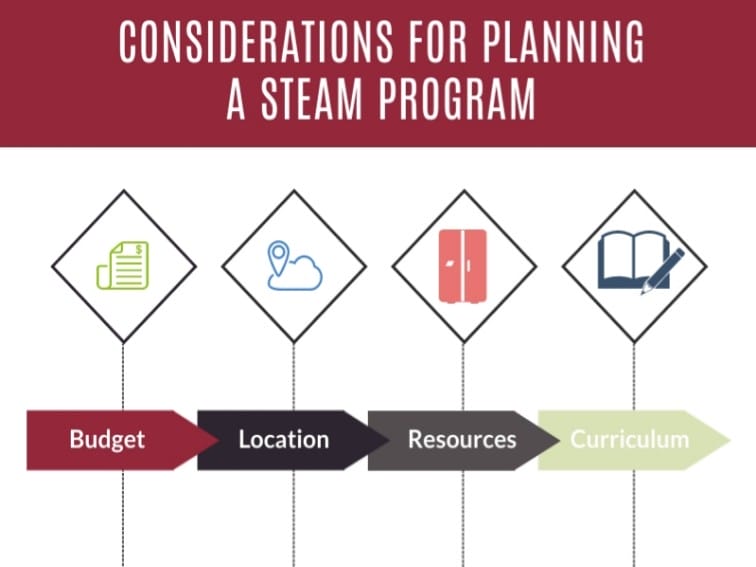How To PLan A STEAM Program In Your School
contributed by Caleigh Heenan
As a teacher in her 13th year, I’ve seen many educational initiatives come and go.
However, one recent trend in education has long been a passion of mine: authentic, personalized learning. I believe that differentiation is the key to success and that hands-on, problem-based learning promotes deep understanding and creates life-long learners.
Recently, STEM and STEAM programs have been at the forefront of K-12 educational discussions. According to the NMC/Horizon Report (2017), a report that identifies technologies that have the potential to impact learning in K-12 classrooms, “[STEM/STEAM programs] invigorate schools to value the learning process itself and leave room for more flexible outcomes as students take initiative, embrace trial and error, and express their knowledge in new ways.”
Such programs utilize COVA, a learner-centered, active-learning approach to teaching that provides students with the chance to experience choice, ownership, and voice throughout a variety of authentic learning experiences (Harapnuik, 2018). In The Push for STEM Education (TeachThought Staff, 2019), the author provides a variety of reasons for the rise in STEM education programs, including combatting automation and the changing face of jobs.
When the Art teacher in my small, Southern New Jersey school district, retired last year, my principal made the bold decision not to hire for the position. Rather, she chose to create a position for a STEAM teacher for Preschool through Sixth grades. Given my passion for this hands-on learning, I was selected to create and teach the new program in the coming school year.
While extremely excited about this amazing opportunity, I was equally overwhelmed by the challenges facing me. Words like ‘curriculum’, ‘budget’, ‘learning space’, and ‘technology’ swirled around in my mind on a daily basis. Slowly but surely, the program took shape and was ready to go on that first day in September. Throughout this year, I often wished I had someone to talk with who was attempting to implement a similar program.
While I did reach out to other local schools with STEM/STEAM programs, many of them did not have programs yet or were not as far along in the implementation process. In the hope of supporting others who may be going through the process, this article will share several considerations and tips for implementing a STEAM program in one’s own school.
4 Steps For Planning A STEAM Program In Your School
1. Establish a budget range
Question: What’s the budget?
The first step of successful planning is knowing your budget. Budgets can range from $250-$10,000 dollars, depending on the size of your district. As I was combining the budget of the Art teacher with my own classroom budget, I knew that I was going to have $3,500 to create this program.
Through discussions with local STEM/STEAM teachers, I determined that this is at the low-to-medium end of typical STEM/STEAM budgets in this region. However, there are many grant opportunities out there for STEM education. Additionally, seek out local businesses for donations.
With a bit of creativity, strong local connections, and community support, your budget can do more than you’d think.
2. Clarify learning places and spaces
Question: Where will the learning happen?
The next step in planning is to select a location.
Meeting early on with administrators to determine options for the location of the STEAM studio is key. Art rooms can be great spaces due to storage and space. However, Science classrooms also make great spaces. If a typical classroom is all that’s available, that’s great, too! When selecting the classroom, keep in mind that it helps promote a feeling of community when the classroom is located in an area that is accessible to all students.
3. Identify existing and need-to-get resources
Question: What do we have and what do we still need?
With your budget set and location locked down, it is important to examine the current resources you have available. Resources can include classroom supplies, technology, furniture, programs, and even lists of community organizations and businesses. It is helpful to send out emails (especially at the end of the year) asking for various supplies from other teachers. If possible, create a space within the building for teachers to place unwanted items and furniture.
‘Traditional’ classroom furniture does not always function well in a STEAM studio, so researching options for building collaborative working spaces can be very helpful in creating the learning space. It is important to designate an area for whole-class discussion. For example, students could begin and end class on a large carpet. Organizing the resources can be time-consuming and tricky, but definitely ask your fellow teachers to lend a hand!
This allows others to know what items you have available for use, and they may be able to give you suggestions for materials you may need.
4. Develop a curriculum
Question: What will students learn?
The final step in the planning process to integrate STEAM into your curriculum is to actually develop the curriculum.
Start with the standards your school would like you to cover, and then use a backwards by design template, such as an Understanding by Design template or a 3-Column Table, to plan. Prior to writing your curriculum, meet with the principal to determine the schedule for the STEAM studio.
This helps determine the number of units that would need to be built for each grade level and the approximate length of lessons. As STEAM is learner-driven, it can be hard to determine specific outcomes. Therefore, planning typical pencil-and-paper assessments was not an option. Rather, it was essential to develop a rubric that would be used throughout all grades to track student learning.
Tomorrow in Part 2, we’ll shift from broader planning to look at tips to actually bring a STEAM program into your classroom.
Resources
Harapnuik, D. (2018). COVA [web log post]. Retrieved from
http://www.harapnuik.org/?page_id=6991
NMC/CoSN. (2017) NMC horizon report: K-12 edition. Retrieved from
TeachThought Staff. (2019). The push for stem education. Retrieved from
